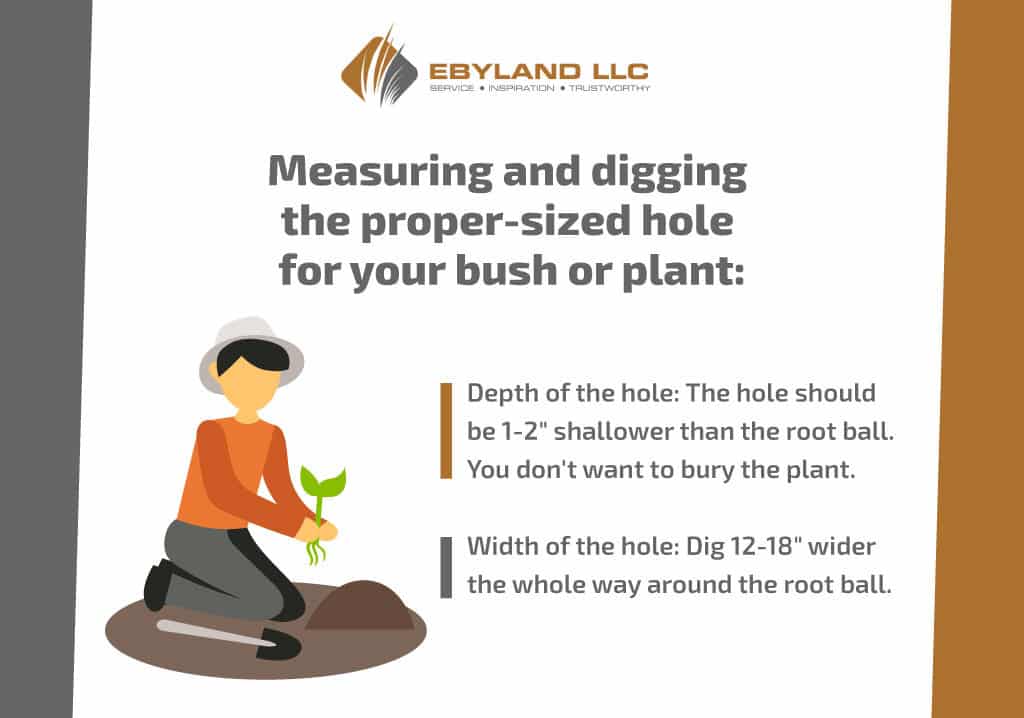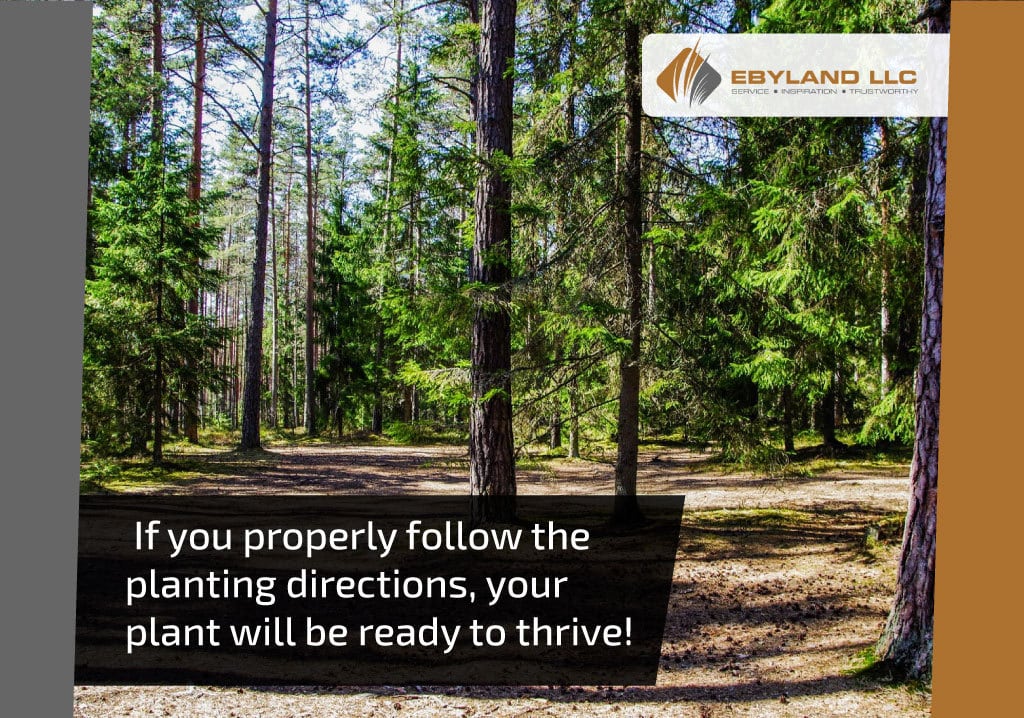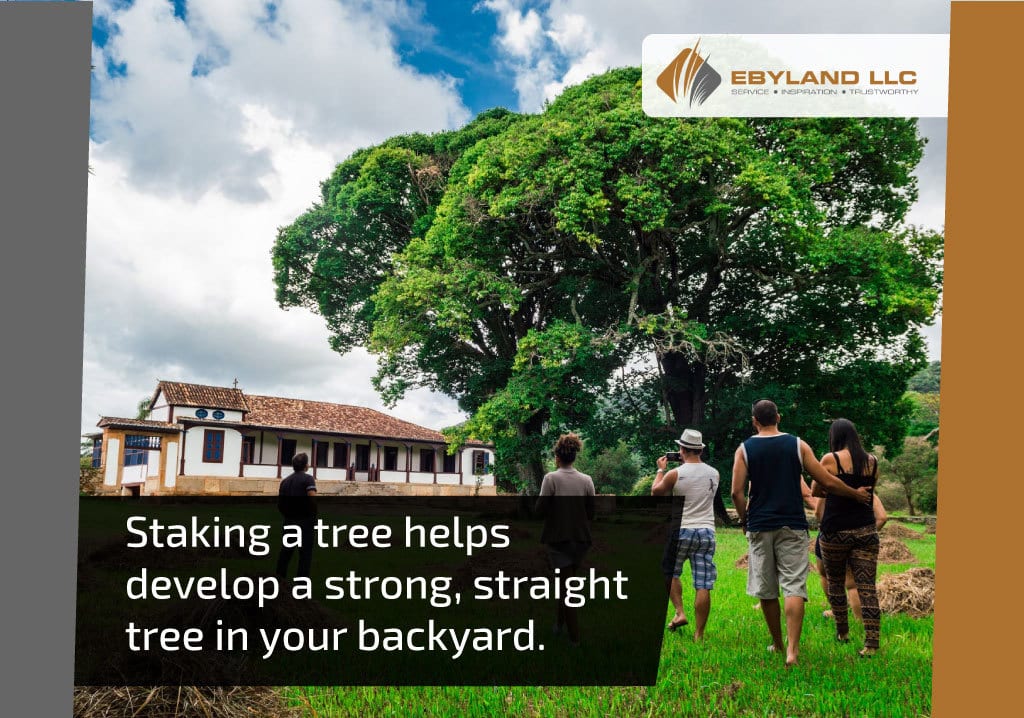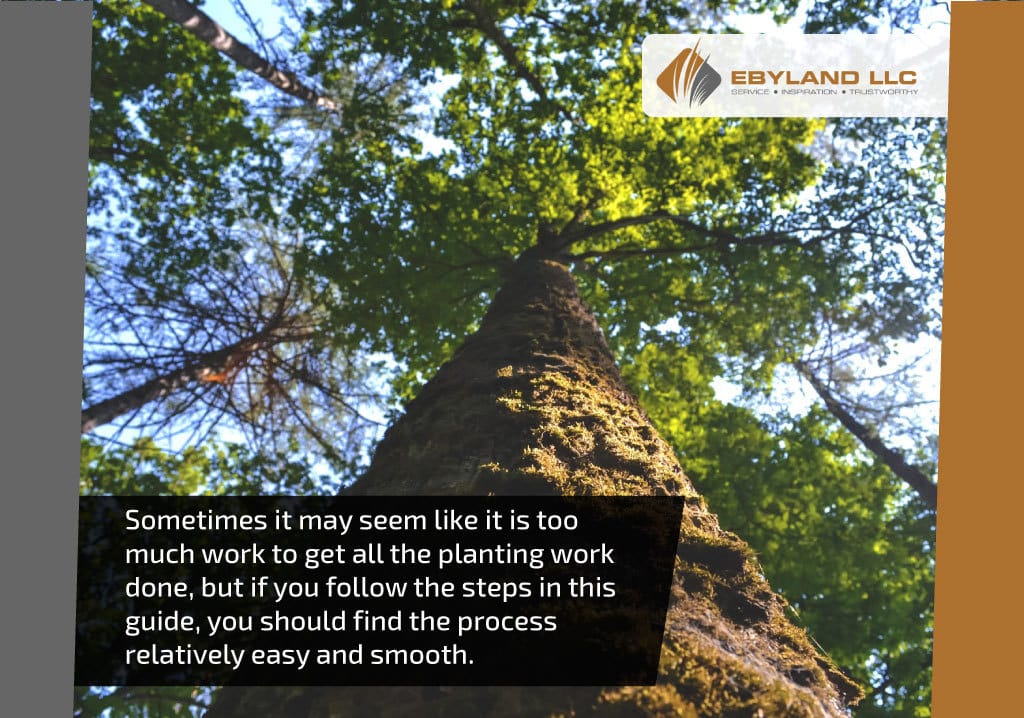How To Plant A Tree Or Shrub – The Ultimate Guide
If you are looking to add majesty and beauty to your home, consider planting a tree!
Trees bring many benefits to a home. According to the Arbor Day Foundation, trees help control stormwater, fight climate change, raise property values, and save energy.

Of course, planting a tree or large shrub takes more preparation and planning than planting smaller shrubs or bushes. But the return on investment usually is worth it!
At Ebyland, we provide a variety of landscape supplies, and we're always eager to help you with your backyard projects.
That's where this guide comes in; we will go over everything you need to know about how to plant a tree or large shrub!
Are you ready to learn about planting trees?
Let's get started!
Before You Purchase Your Tree
Before you purchase a tree at your local nursery, you should ask yourself several questions. Answering the following three questions will help you choose the right tree or shrub and plant it in the correct location in your yard.
After all, you don't want your tree to take root only to wish you had planted it elsewhere! It's hard to replant your tree once it gets established, so carefully decide where you put it.
You can do online research to help you, or if you live close to Cumberland, MD, our nursery team at Ebyland would love to help you!
What is the purpose of the tree?
If you know what purpose you want your tree to serve, you can choose the right kind of tree for the job and your location.
Many types of trees are available for your home, such as fruit trees, shade trees, trees for aesthetic purposes, and trees to attract more wildlife. Before you decide, consider which tree type would be best for you.
Where will you plant the tree?
Take a look around your property and decide where you want to plant your tree. The following guidelines will help you find the perfect spot.
First, you want to know the location of underground utility lines, wires, or pipes. If you plant a tree close to these, you could have severe issues in the future.
Second, how close do you want the tree to your home? Some trees may damage your home's foundation over time if you plant them too close. However, some types of trees may be just fine planted close to your home, so where you want to position your tree may affect what kind of tree or shrub you get.
Third, think about shade considerations. Studies show planting large trees on the east, west, and northwest sides of your home can reduce air conditioning costs by 35%!
And fourth, think about your soil and drainage conditions. If your soil is not conducive to growing plants or doesn't drain water well, it needs amendments before it is ready for your tree.
Once planted, a tree is a permanent fixture in your yard, so place it well!
Will the tree flourish in your climate?
While trees may be more adaptable to different climates than flowers or smaller bushes, you must consider your area's climate.
For example, planting palm trees in the North will not end well!
Many fruit trees also require certain climates or weather patterns to thrive and flourish, though there are some trees that seem to flourish anywhere.

Choosing A Tree
When you look at trees at your local nursery, here are a few things to watch for when you pick out your tree.
If you are unsure what the ideal tree is for your home, check with the nursery staff for their help and recommendation.
Does the tree have desirable branch angles?
The best branch angles for optimum growth are 45 to 90 degrees about the trunk. If the branches are under 45 degrees, the limbs can fracture as they grow and become heavier. That means fallen branches and sticks all over your yard.
Are there dead or dormant branches?
A few dead leaves are not a big deal, but a sapling with many dead branches is not a good tree to purchase and plant. You don't want a sapling that is going to die.
Is the tree's container an appropriate size?
Every tree and bush root ball is different but should be appropriately sized for the sapling. If a large sapling has a small root ball, the tree may miss vital roots and have trouble taking root in your yard.
Digging The Hole
Once you purchase your tree, it's time for the most labor-intensive part of the process: digging the hole!
When you dig the hole for your tree or shrub, there are two different digging dimensions:
- The depth of the hole
- The width of the hole
When it comes to depth, it's common to make the hole too deep. You actually want the hole's depth to be 1-2" shallower than the root ball!
When you place the tree's root ball into the hole, the top of the ball should be just slightly above ground level. This helps protect the tree's root collar and stem from rotting and helps it grow better.
When it comes to the hole's width, you want it to be 12-18" wider the whole way around the root ball. This allows plenty of space to mix in amended soil and add the proper compost to help your tree grow and thrive.

Amending The Soil
After digging the hole, you'll have a large mound of dirt left over. You will use some of this dirt to backfill around the newly planted tree, but before you fill the hole, it's recommended to amend the soil and add fertilizer.
Why is amending the soil so important?
New trees and shrubs need proper fertilizer and soil to establish good roots and grow. Some dirt may have this naturally, but most soils must be enriched to give the tree the proper nutrients to flourish and take off.
We recommend a mixture of total compost and bio-tone fertilizer.
The total compost helps break up harder soil and clay, allowing for better soil aeration and root development.
Bio-tone fertilizer has root-promoting bacteria that help develop bigger and healthier roots, resulting in a healthier plant.

We recommend the following amounts of total compost depending on your root ball size:
- 1-gallon shrubs: ⅙ bag
- 3-5 gallon shrubs: ⅓ bag
- 12-16” root ball trees: ½ bag
- 18” or larger root ball trees: 1 bag
Mix the compost and fertilizer with the dirt from the hole, and use this amended soil to fill the hole around the tree or shrub.
It is common to have some extra soil when you are done planting. Excess dirt is usually handy to have around; chances are there is somewhere on your property where you could use it to level a space or fill in a pothole.
A note on watering with amended soil: Amended soil tends to dry out more quickly than regular garden soil and topsoil. Because of this, monitor the moisture content around the plant for the first several months and water accordingly. See our section on “Watering the Tree” below for more information.
Planting Your Tree
Once you have prepared your hole for planting and mixed the amended soil, you are ready to plant your tree!
Depending on the size of your tree or shrub, the roots come in either a balled & burlapped package or a container.
Each of these has its own set of best practices for planting. Let's talk about the best way to plant each type of root system.
Planting balled & burlapped plants:
- Don't remove the wire basket and burlap! This is a common rookie mistake. Instead, place the whole package into the hole. Ensure the root ball's top is either level or slightly higher than the ground level.
- Ensure the tree is straight, and then fill in the amended soil around the root ball.
- Check the tree regularly to ensure it remains straight as you fill in the hole. Also, lightly tamp the soil several times as you fill it with the amended soil.
- When the amended soil is about ¾ of the way up the root ball, remove the strings from the root ball.
- Cut and remove, or pull back, all the burlap at the top of the root ball.
- Fill the rest of the hole with enriched soil until the soil is back to its original level.
- Create a small ring 6-10" from the tree's base with extra dirt. The ring should be several inches high. This traps water and moves it slowly into the tree's roots.
Planting Container Plants:
- Slowly remove the plant's root ball from the container. Discard the container.
- If there are roots encircling the root ball, take a knife and make six even cuts from top to bottom around the sides of the root ball. Cut about ½" deep.
- Make several ½" deep cuts on the bottom of the root ball as well.
- Set the tree or shrub in the hole. Make sure the top of the root ball is either level or slightly higher than the ground level.
- Make sure the plant is straight (who wants a tree that looks like the leaning tower of Pisa in their front yard?!), and then begin filling in the amended soil around the root ball.
- Check the plant regularly to make sure it remains straight as you fill in the hole. Also, lightly tamp the soil several times as you fill it with the amended soil.
- Fill the rest of the hole with enriched soil until the soil is back to its original level.
- Create a small ring 6-10" from the base of the tree with extra dirt. The ring should be several inches high. This traps water and moves it slowly into the plant's roots.
If you follow these directions, you will get a tree or bush that is properly planted, stands straight, and has the correct amended soil to begin thriving in its new location!

Mulching Around Trees
Mulching around trees is not required, but it is highly recommended.
Not only does mulching your new planting make it look appealing, but mulch also conserves moisture, releases nutrients into the soil around your plant and helps maintain a more consistent soil temperature.
Mulching also creates a nice radius around the tree when you are mowing or trimming, and this helps protect the new tree or shrub from damage.
Several tips on mulching around the new tree:
- The mulch should be 2-4" inches deep.
- Don't make your mulch level the whole way around. Instead, observe the ridge you made with the dirt around the tree and follow the same contour. Remember, you want the water to be trapped inside the ring!
- Do NOT put mulch directly against the trunk. This can result in decay and harm to the tree's root collar. Instead, gently phase the mulch to slope down gently and stop right before it touches the actual trunk.
For more information on mulching, look at our blog post on the ultimate guide to mulching.

Watering The Tree
Your newly-planted tree will need water to survive!
The actual amount of water it needs depends on the season and climate.
However, since the root ball dries faster than the soil around it, it needs regular watering to survive.

If you are unsure whether or not the root ball needs water, the best thing to do is gently dig down into the root ball with your hands and check how moist the earth is.
If the root ball is dry, then it needs to be watered. If it is very wet, wait a day and check again. Too much water can damage newly planted trees. Watering isn't rocket science--it's mainly common sense!
A slow, deep watering method is the best way to water new plantings. Watering slowly helps the water penetrate the root system. If you water too quickly, the water simply runs off and never reaches the tree's roots.
Here are some general watering guidelines for newly planted trees:
- 1-3 gallons should take 15-20 minutes to water the plant
- 4-7 gallons should take about 30 minutes to water the plant
- If you use a sprinkler, run it for at least 6 hours. While natural rain and sprinklers are good, it takes a lot of time to have enough water to water the tree properly.
- Monitor the tree's root ball for at least six months; closer to 1 year is preferred.
How To Stake The Tree
Finally, it's time to stake your tree, which helps it remain straight if it's top-heavy or in a windy area. You don't want to skip this step, as this could cause you to have a crooked tree on your property.
Measure 3-4' from the tree's base and pound three stakes into the ground at even increments around the tree.
Connect these stakes to the tree trunk with a suitable product for the tree. (If you use non-approved materials, you may damage the trunk.)
Don't overtighten the lines. Instead, allow for some movement so the tree grows and develops naturally.
After one growing season, the tree's roots should be established enough to maintain straight, vertical growth, and you may remove the stakes now.

Conclusion
Planting a tree or shrub is a great way to add value and beauty to your property!
Sometimes it may seem like it is too much work to get all the planting work done, but if you follow the steps in this guide, you should find the process relatively easy and smooth. And believe us, the return on investment is wonderful if you're patient enough to wait for it.
If you live in Cumberland, MD, or nearby, then visit the Ebyland Nursery for available trees and plants in Cumberland. We offer a wide variety of trees, plants, and shrubs that are ideal for the local climate.
We carry everything you need to create a beautiful backyard!
- Stone
- Outdoor furniture
- Wood fuels
- Hardscape materials
- Grills and fire pits
- Outdoor playsets
- And more!
As your local landscape center, we have a knowledgeable and friendly staff who would love to help you pick the perfect plants for your flowerbed, backyard, and home. And if you are unable to plant them yourself, we can partner you with a local trusted landscaping contractor.
Contact our team or visit our greenhouse today. We look forward to helping your backyard dreams come true!









